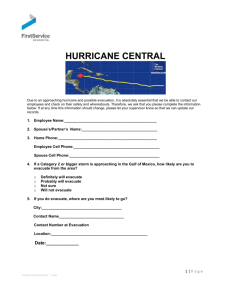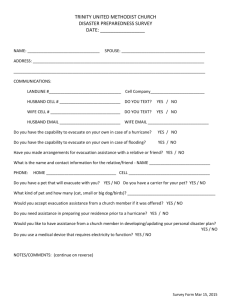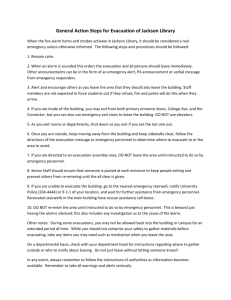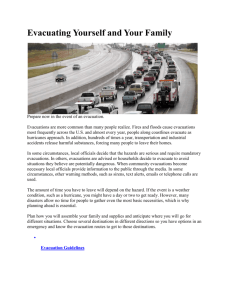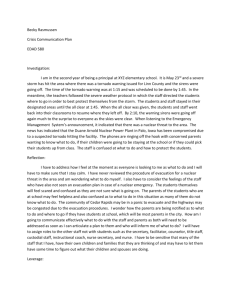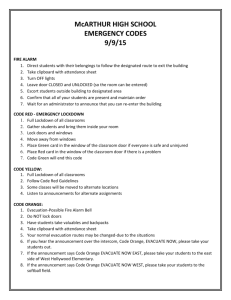Crisis Management Plan - North Beach School District
advertisement
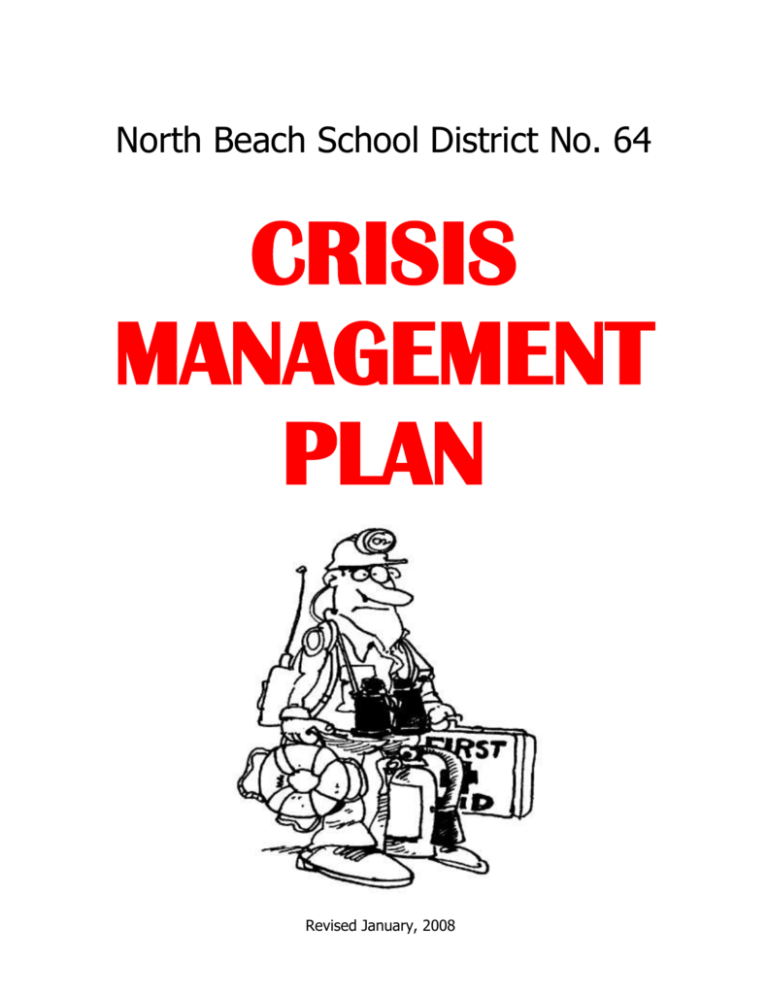
North Beach School District No. 64 CRISIS MANAGEMENT PLAN Revised January, 2008 IN APPRECIATION The North Beach School District would like to extend its appreciation for the efforts of the following committee members who participated in developing the original emergency plan. Bill Weidman Dave Cowardin Delvin Zimmermann Deputy Matt Organ Diane Nelson Don Sheaffer Doug Moore Glen Cooper John Fry Karen Rasmussen Larry Brewer Linnea McCutcheon Mike Waldo Mona Mile-Koehler Nick Payne Russ Fitts Karen Ellingson Bruce Hansen Dave Wayman Richard Zimmerman Patrice Timpson The format of this document was borrowed from J. Berra Engineering, Inc., Crisis Management Plan for Schools. 2 TABLE OF CONTENTS Crisis Organization 5 Violent Actions 6 Weapons/Lockdown 7 Suspected Weapon 8 Intruders 9 Shelter in Place 10 Evacuation 11 Fire or Explosion 13 Hazardous Material Release 15 Utility Failure – Inside Gas Leak 16 Utility Failure – Power Outage 17 Utility Failure – Power Line Down on School Property 18 Utility Failure – Water Shortage 19 Bomb Threat 20 Bomb Threat Checklist Form 21 Flooding 22 Earthquake – Preparedness Measures 24 Earthquake – During the Earthquake 26 Earthquake – After the Quake – First Hour Priorities 27 Missing Student or Runway Student 28 Unauthorized Removal of Students 31 3 Tsunami Evacuation – Pacific Beach Elementary 32 Tsunami Evacuation – Ocean Shores Elementary 33 Tsunami Evacuation – Junior/Senior High School 35 Lists of Schools 36 Emergency Phone Number 37 Closing of Schools 38 Building Floor Plans – Pacific Beach Elementary 39 Building Floor Plans – Ocean Shores Elementary 40 Building Floor Plans – Junior/Senior High School 41 4 CRISIS ORGANIZATION DISTRICT CRISIS TEAM SUPERINTENDENT OPERATIONS SITE CRISIS TEAM PRINCIPAL OTHER PARTICIPANTS COUNTY AGENCIES TEACHER 911 BUSINESS SECRETARY SAFETY AIDES MEDIA RELATIONS NURSE TRANSPORTATION COUNSELOR MAINTENANCE CUSTODIAN FOOD SERVICE OTHER DESIGNATED PERSONNEL SCHOOL BOARD PRESIDENT LAW ENFORCEMENT FIRE DEPARTMENT MEDICAL PARENTS NEWS/MEDIA 5 VIOLENT ACTIONS TEACHER VIOLENT ACTIONS Physical Assault Fights Verbal Assault Verbal Threat Make verbal contact in a calm, lowtoned voice If behavior does not cease, shout “STOP”, and then lower your voice and encourage students to talk about the issues someplace else Try to get individuals to a more isolated area so they can calm themselves without losing face; or, try to get the area emptied of other students so there is less audience and less danger PRINCIPAL’S OFFICE Assess situation and intervene if requested by teacher 911 if students refuse to DO NOT leave the students alone until they are calmed down Call Discuss their behavior and its consequences only after they are calm Notify the Superintendent’s office cooperate Assist police in anyway requested Understand that violence is timelined; if you can delay long-enough, it will subside Follow disciplinary action according to district policy of student conduct Never grab or touch a violent student unless they are causing harm to themselves or others File an incident report Give the students a choice by clearly stating, “You and I must go to the principal’s office. If you refuse to go with me, I will notify the principal’s office, who will probably call the police” If the students refuse to cooperate by rendering the above steps invalid, notify the principal or assistant principal that you need help with a violence problem 6 WEAPONS/LOCKDOWN TEACHER IF INTRUDER IS IN SAME ROOM AND SHOTS HAVE BEEN FIRED Tell class ‘GET DOWN AND TAKE COVER” Do not raise your voice or challenge the intruder Do what you are asked to do Use sound judgment, if possible await police rescue IF INTRUDER IS IN AREA AND NO SHOTS HAVE BEEN FIRED IF INTRUDER’S NOT IN AREA AND A “LOCKDOWN” IS ORDERED Quickly survey the hallway by your classroom. Order any students in hall or restroom into your room Notify principal’s office ASAP and advise whether a weapon is suspected or visible Try to calm the students under your care Do not approach intruder or attempt to confiscate the weapon If a weapon is visible or intruder is threatening, ask the intruder in a calm voice for permission to evacuate the rest of the class Lock your door, close window coverings and move students to a corner of the room out of sight of the entry door Have the class sit on the floor and keep quit Open door only to a police officer and follow his instructions. If told to evacuate, take class list Evacuate quietly, if allowed If evacuation is not allowed, keep talking with the intruder until police arrive 7 If students are outside and teacher receives “lockdown” alert, escort students to evacuation site. Do NOT reenter building SUSPECTED WEAPON PRINCIPAL’S OFFICE Call 911 for law enforcement Have police officer bring the student to the office with backpack, purse, books, and other possessions Ensure that at least 2 adults and a police officer are present at the meeting Tell the student what is suspected and ask the student where the weapon is hidden If the student denies or refuses, ask the student to empty pockets. Police officer, principal, or asst. principal should search backpack If search yields nothing, 2 adults, the police officer, and the student go to the student’s locker for a search If a weapon is found, police officer will remove student from campus Notify a parent Call the superintendent Follow disciplinary action according to district policy of student conduct 8 INTRUDERS TEACHER Report any suspicious person to the principal’s office immediately: VISITOR PASS REQUIRED! PRINCIPAL’S OFFICE Approach the intruders and ask them to get a Visitor’s Pass at the office PRINCIPAL’S OFFICE (continued) Ask for identification Direct and/or accompany them to the proper office If the situation is very severe announce an “intruder on campus” on P.A. System, which means all teachers will lock doors If they have no acceptable purpose, ask them to leave If they refuse to leave If “intruder on campus” is announced, have administrative staff evacuate any students who have been locked out of their classroom or who are in public areas to a safe area inside or outside the building Remind them that they are in violation of the law Alert them that the police will be called Notify the Superintendent’s office If they continue to refuse to leave call 911 for law enforcement File an incident report 9 SHELTER IN PLACE DEFINITION Sheltering in Place is the use of any classroom or office for the purpose of providing temporary shelter from a hazardous material release PRINCIPAL’S OFFICE Receive information and instructions to shelter in place, rather than evacuate, due to a nearby hazardous material release EMERGENCY Hazardous Material Release - Chemical Plan Accident - Chemical Train Derailment - Chemical Truck Overturning - Pipeline Rupture Drill Activate the school shelter in place plan by announcement over the P.A. system Require all persons in outside areas to go indoors Ensure that appointed caretakers assist handicapped students Ensure that maintenance immediately shuts off all heating, cooling and ventilation systems for entire campus TEACHER Consider instructing teachers to seal doors and windows with duct tape in severe cases Move all students indoors Notify the Superintendent’s Office Close all windows and doors to the shelter Allow no one to leave the shelter during the emergency Turn off room heating, cooling, or ventilation systems Use reasonable judgment in allowing outsiders into a shelter during the height of the incident If there appears to be air contamination within the shelter, place a wet handkerchief or wet paper towel over the nose and mouth for temporary respiratory protection Be in contact with the police department for continuous information and instructions until the incident is under control Continue to follow the instruction given over the P.A. system Do not allow anyone to leave the shelter until the “ALL CLEAR” Announce the current status of the incident at frequent intervals over the P.A. system until “ALL CLEAR” 10 EVACUATION TEACHER Evacuate when you hear your buildings appropriate notification Be aware of pre-designated primary and alternate evacuation routes Take class list and emergency kit with you Close door and turn out lights as students leave Leave the building in an orderly manner without rushing or crowding EMERGENCY Earthquake Fire Fallen Aircraft Chemical Release Bomb Threat Drill Tsunami If the situation warrants, vehicle evacuation will be used to transport students to another site N If the emergency calls for an evacuation without the use of vehicles, walk from the building in the stated course (see Tsunami route) Always evacuate crosswind and/or upwind away from any emergency by a safe route Students should be evacuated at least 300 feet from building and out of the way of emergency vehicles Reassemble the students and check roll to ensure that all students are accounted for Report any missing students immediately Note on class list any students who are released to parents Return to your room when you are instructed that it is safe to do so 11 W Go cross wind and/or upwind to evacuate away from any emergency S E PREDOMINATE WIND DIRECTION EVACUATION (Cont’d) PRINCIPAL’S OFFICE PRINCIPAL’S OFFICE (Continued) Sound alarm and signal an evacuation Notify the Superintendent’s office Use P.A. announcement if alternate evacuation route or alternate assembly area is to be used for safety Call Advise whether primary or alternate assembly area will be used Advise whether students need to be transported by bus to another site 911 After total roster is collected, preappointed staff members should search building for any missing students Advise whether ambulances are needed Advise nurse and qualified staff to administer first aid as necessary If students are to be evacuated to another site or they are to be dismissed for the day, organize a system for loading the buses as quickly and safely as possible Evacuate all staff and students to predesignated evacuation routes Ensure that appointed caretakers assist handicapped students If students are to be dismissed for the day, a checkout area should be established Pre-appointed staff members should search all areas of building for stragglers Students should only be released to parents or those listed on emergency release form Principal confers with search team for status report Signal “ALL CLEAR – RETURN TO CLASS” when appropriate File an incident report 12 FIRE OR EXPLOSION TEACHER Evacuate when you hear your building appropriate notification Be aware of pre-designated primary and alternate evacuation routes Take class list and emergency kit with you Close door and turn out lights as students leave N Leave the building in an orderly manner without rushing or crowding If the situation warrants, vehicle evacuation will be used to transport students to another site If the emergency calls for an evacuation without the use of vehicles, walk from the building in the stated course (see Tsunami route) Always evacuate crosswind and/or upwind away from any emergency by a safe route Students should be evacuated at least 300 feet from building and out of the way of emergency vehicles Reassemble the students and check roll to ensure that all students are accounted for Report any missing students immediately Note on class list any students who are released to parents Return to your room when you are instructed that it is safe to do so 13 W Go cross wind and/or upwind to evacuate away from any emergency S E PREDOMINATE WIND DIRECTION FIRE OR EXPLOSION (Cont'd) PRINCIPAL’S OFFICE PRINCIPAL’S OFFICE (Continued) Sound alarm and signal an evacuation Use P.A. announcement if alternate evacuation route or alternate assembly area is to be used for safety Notify the Superintendent’s office Advise whether primary or alternate assembly area will be used Call 911 Advise whether students need to be transported by bus to another site Advise whether ambulances are needed After total roster is collected, preappointed staff members should search building for any missing students Advise nurse and qualified staff to administer first aid as necessary Evacuate all staff and students to predesignated evacuation routes If students are to be evacuated to another site or they are to be dismissed for the day, organize a system for loading the buses as quickly and safely as possible Ensure that appointed caretakers assist handicapped students Pre-appointed staff members should search all areas of building for stragglers If students are to be dismissed for the day, a checkout area should be established Ensure that custodian and cafeteria have turned off all motors, fans, and other power-driven equipment Students should only be released to parents or those listed on emergency release form Signal “ALL CLEAR – RETURN TO CLASS” when appropriate File an incident report 14 HAZARDOUS MATERIAL RELEASE A DECISION MUST BE MADE TO SHELTER IN PLACE OR TO EVACUATE DURING A HAZARDOUS MATERIAL RELEASE EMERGENCY Chemical Truck Overturning Chemical Train Derailment Chemical Plant Accident Pipeline Rupture Outside Gas Leak FIRE DEPARTMENT HAZMAT DIVISION 911 PRINCIPAL’S OFFICE Contact or receive a decision from the Fire Department’s Hazardous Material Division on whether to shelter in place or to evacuate during a hazardous material release IF TOLD TO SHELTER IF TOLD TO EVACUATE Follow the evacuation procedures Follow the shelter in place procedures 15 UTILITY FAILURE Inside Gas Leak PRINCIPAL’S OFFICE Notify the building occupants by P.A., bullhorn, or oral announcement to evacuate, whenever a strong gas odor is reported TEACHER STOP Do not use the fire alarm signal as it may take students into areas of highest gas concentration Call 911 Notify the gas company Notify the superintendent’s office Oversee the evacuation to the designated assembly point Determine when the building is safe for reoccupancy after conferring with the authorities File an incident report CUSTODIAN Ventilate the area, starting where gas concentration is strongest Evacuate in accordance with fire drill procedures Evacuate to the assembly point STOP Operate Manual controls to shut off open flame devices STOP Do not operate electrical switches Route students around and away from areas of strong gas odor Do not operate electrical switches Assist gas company personnel in finding and fixing the gas leak Advise the principal when the building is safe for reoccupancy 16 Take roll call at the assembly point Follow the shelter in place procedures UTILITY FAILURE Power Outage PRINCIPAL’S OFFICE CUSTODIAN Call the superintendent’s office – wait for directives Distribute available flashlights Instruct the occupants of the building to either remain in place, or to dismiss by using messengers Check on emergency lighting in all areas DO NOT CALL PUD Notify Food Service to take action TEACHER Follow the instructions from the principal’s office to either remain in place or to dismiss FOOD SERVICE Prepare cold food menus when possible Monitor food storage temperatures 17 UTILITY FAILURE Power Line Down on School Property PRINCIPAL’S OFFICE Notify the building’s occupants by bullhorn or messenger, if PA. System has failed Designate someone to guard the area of the downed power line to prevent students and staff from going near CUSTODIAN Notify PUD Distribute available flashlights Notify the Superintendent’s office Assist by checking whether emergency lighting is working File an incident report TEACHER Follow the instructions from the principal’s office 18 UTILITY FAILURE Water Shortage PRINCIPAL’S OFFICE Notify the building’s occupants by bullhorn or messenger, if PA. System has failed Call the appropriate water district office Call the superintendent’s office CUSTODIAN File an incident report Assist the water department in determining the cause and in making the repairs TEACHER Continue normal educational duties 19 BOMB THREAT PHONE CALL RECIPIENT PRINCIPAL’S OFFICE 911 Call for law enforcement and report that a threatening phone call has been received Keep caller on the phone as long as possible and do not hang up If a STUDENT is answering the phones, the student should get an adult to the phone if possible DO NOT mention a bomb, if possible, in order to avoid premature media coverage Signal to someone near you to alert principal’s office Notify the Superintendent’s office Write down everything caller says Make decision whether or not to evacuate building As soon as possible, use bomb threat checklist, by phone or back of document If evacuation is necessary, see evacuation procedures DO NOT USE RADIOS OR ELECTRONIC BELLS Ask the questions on the checklist Make an educated guess as to caller’s sex, age, race, and accent Bombs can be activated by radio signals and electronic devices Pass information and instructions to the teachers orally by bullhorn or messenger Identify any background noises After call is over, write down any impressions of caller Establish search terms of employees Under no circumstances are they to touch a suspicious package TEACHER Principal should remain in office to coordinate search team response and to act as a guide for the police Collect class list Wait for “ALL CLEAR” from police before allowing students back in school Evacuate when advised File an incident report Take attendance when students are assembled away from school Give roll and count to Principal’s office 20 LOG CALL BOMB THREAT CHECKLIST FORM a. Date reported b. Time reported c. How reported d. Exact words of caller ASK QUESTIONS e. When is the bomb going to explode? f. Where is the bomb right now? g. What kind of bomb is it? h. What does it look like? i. Why did you place the bomb? j. Where are you calling from? IDENTIFY CHARACTERISTICS k. Description of caller’s voice Male Female Young Middle Age Old Accent l. Tone of voice Intoxicated Speech problem Hostile m. Background noise n. Time caller hung up o. Remarks 21 FLOODING BUS DRIVER In advance, locate high ground areas along your route Watch for flooding in highway dips, low areas, and around bridges Do not attempt to drive through dips of unknown depth Be especially cautious at night, when it is harder to recognize flood dangers If part of your route is impassable, radio or call the transportation supervisor for a new route IF VEHICLE STALLS If vehicle stalls in area of mildly flowing water and the water is not above the children’s knees, abandon bus to high ground A FLASH FLOOD MAY BE IMMINENT If vehicle stalls in deep water, or vast flowing water, act quickly to save yourself and those depending on you. Request help from passerby. YOU MAY HAVE ONLY SECONDS 22 FLOODING (Continued) PRINCIPAL’S OFFICE TRANSPORTATION BEFORE SCHOOL OPENS BEFORE SCHOOL OPENS During heavy rains, consult with Superintendent’s office on whether school will be open Listen to NOAA or local radio or TV for possible flash flood warnings or flooding in progress Send emissaries to areas known to be flood-prone and assess situation IF SCHOOL IS OPEN Determine whether roads are passable now Assign a staff member to monitor local radio and TV weather advisors Determine whether roads are likely to be passable when school opens Assign a staff member to keep an eye on entry roads to school for possibility of imminent inaccessibility Evaluate whether roads are likely to flood during school day, based on present situation and weather advisories If school must be evacuated, consult with the Superintendent to arrange for early dismissal and necessary transportation Safety Media Relations Transportation Advise Superintendent of assessment IF SCHOOL IS OPEN Protect contents of building by moving books, files and equipment from floors and bottom shelves to tables and cabinet tops Be prepared to reroute buses to more passable roads Continue to monitor weather advisories during the day and inform the Superintendent of any changes in assessment, which might require an early dismissal 23 EARTHQUAKE Preparedness Measures PRINCIPAL’S OFFICE Recognize potential hazards and implement protective measures Train all staff and students and have drills to practice emergency procedures Determine who is trained in various rescue measures and assign responsibility First Aid CPR Fire suppression methods Dealing with trauma & panic Predetermine an emergency evacuation signal if P.A. systems are inoperable Be aware that the school may be isolated from emergency rescue officials, and staff may need to be self-sufficient for many hours Prepare a procedure for releasing students after a quake Establish an emergency release area Emergency release roster should be portable and taken to emergency release area No student should be allowed to walk home Parents should be made aware of this special release procedure 24 EARTHQUAKE (Cont’d) Preparedness Measures – Review Annually POTENTIAL HAZARDS PROTECTIVE MEASURES - WINDOWS – Non-tempered glass will shatter and gouge whatever it hits. - - LIGHTING FIXTURES – Fixtures may fall and break. Fluorescent bulbs will fall and break. CEILINGS – Improperly installed ceilings may come down. Glued titles may fall. Ducts may fall. CHEMICAL SPILLS – In chemistry labs, cafeterias, and custodial supply closets, chemical bottles may fall and break, creating toxic fumes, combustible mixtures, and exposed corrosives. - - FURNISHINGS AND MISCELLANEOUS ITEMS – File cabinets may fall over or fly across the room. Freestanding bookcases, lockers, shelves, and contents will fall over. Heavy objects such as TVs, typewriters, and computers may fly through the air. Screens and maps may become projectiles. Pianos will roll. - - COMPRESSED GAS CYLINDERS, GAS APPLIANCES, AND WATER HEATERS – All of these may pull away from the wall, become projectiles, and create other gas hazards. GAS LINES – Lines will rupture. If gas lines are near a sparking wire or arching motor, and explosion could result. - - - - - - - - - BASEMENTS AND ELECTRICAL SUPPLY – Water pipes may rupture. Basements may flood deeply. Electrical switching mechanisms may become inaccessible. WALL-MOUNTED AND HANGING OBJECTS – Clocks, maps, fire extinguishers, hanging plants, etc. will all pull free and become projectiles. 25 Install transparent shatter-resistant security film on windows. Install tempered glass indoor panels. Support fixtures and bulbs with chains or strapping attached to studs and heavy metal structures. Support ducts with strapping attached to studs and heavy metal structures. Install removable restraining bars across the front of shelves. Post warning signs in areas of hazardous chemicals. Use careful labeling and segregate potentially dangerous reactionary mixtures. Multiple rows of shelves or lockers can be secured to overhead channelshaped (not flat) metal bars attached to struts. Secure single shelves with heavy right-angle brackets and 2” (or larger) molly bolts to a wall stud or floor anchor. Keep file drawers latched when not in use. Move most heavy objects to lower levels. When possible, secure with brackets and bolts. Secure gas appliances and tanks to wall studs with 2 metal or nylon belts; one should be about 1” above the floor. Install automatic gas shut-off valves to main intake line. Train custodians, cafeteria workers, and lab students to shut off all gas lines before dropping to the floor. Eliminate these items when possible or secure with brackets, bolts, and metal straps to wall studs. EARTHQUAKE (Cont’d) During the Earthquake ALL DEPARTMENTS Indoors or outdoors, take action at the first indication of ground shaking IF INDOORS IN A LAB, A KITCHEN, OR A PHYSICAL PLANT IF INDOORS IN A ROOM Stay inside Extinguish all burners Move away from windows, shelves, and heavy objects and furniture that might fall Stay clear of hazardous chemicals that may spill Take cover under a table or desk (NOT IN A DOORWAY) Take cover under a table or desk and move with it ‘DROP AND TUCK” IF OUTDOORS If the table or desk moves, hold the legs and move with it Move to an open space, away from buildings and overhead power lines IF INDOORS IN A HALL, ON A STAIRWAY, OR IN AN OPEN AREA Lie down or crouch Keep looking around for potential dangers that may demand your movement Move to the interior wall Turn away from windows IF ON A SCHOOL BUS ‘DROP AND TUCK” Stop the bus away from power lines, bridges, overpasses, and buildings Students should remain in their seats and hold on 26 EARTHQUAKE (Cont’d) After the Quake – First Hour Priorities TEACHER PRINCIPAL’S OFFICE Stay under shelter until shaking stops Stay under shelter until shaking stops Make a quick assessment, make decision whether to evacuate and whether to call officials If your classroom is in imminent danger of fire, evacuate class immediately 911 for rescue If not in imminent danger, talk calmly to students, listen for instructions; review with students the procedure for alternate evacuation routes around an obstructed route or blacked exit Signal an evacuation with whatever means available FOLLOW EVACUATION PROCEDURES Extinguish any minor fires Keep this book and a cellular phone with you Check students for injuries, report any critical injuries to office. Account for all students Be prepared to respond quickly to: injuries, fires, hazardous materials, and trauma Administer critical first aid yourself; help may be a long time coming You and your staff may have to be self-sufficient for many hours or even days If you hear an instruction to evacuate, make a good judgment decision on whether students can be moved NURSE/SECRETARY If evacuating, follow procedures, be alert for hazards along route and for aftershocks, be prepared to order a “DROP AND TUCK” along route if on foot Administer first aid if required CUSTODIAN (S) & CAFETERIA STAFF Account for all students again Calm and reassure frightened students All gas and electricity should be shut off at the main switches if possible Release students to appropriate adults All gas appliances and motors should be shut off Assist with first aid of the injured 27 MISSING STUDENT OR RUNAWAY STUDENT TEACHER Report to Principal’s office any student who is missing During school hours after student has been listed as “PRESENT” PRINCIPAL’S OFFICE Obtain information from cumulative records Search campus, including an “ALL CALL” on P.A. Call parent or those listed on emergency release form Advise parents to call the police if student is not located within a reasonable period of time Note that PARENT must make this call Call the Superintendent’s office DO NOT RELEASE ANY INFORMATION TO THE MEDIA Refer inquires to Superintendent When police arrive at school, work closely with them If student is located, notify parent immediately 28 MISSING STUDENT OR RUNAWAY STUDENT (Cont’d) During school hours when student is missing between home and school PRINCIPAL’S OFFICE Check with parent if student does not arrive at school During school hours when student is missing between home and school (cont’d) Is student legally absent? If answer is ‘YES”, STOP procedure PRINCIPAL’S OFFICE Could student be lost? Call the Superintendent’s office Is student suspect of being a runaway? If student is a bus rider, call Transportation Is the student suspected of being truant? Are any of his friends also missing? DO NOT RELEASE ANY INFORMATION TO THE MEDIA Refer inquiries to the Superintendent’s office Call parent or those listed on emergency release form If police arrive at school, work closely with them Ask for student’s possible route to school and for means of transportation If student is located, notify parent immediately Advise the parents to call the police if student is not located within a reasonable period of time Note that PARENT must make this call Ask parent to notify school if student is located A designated person may want to drive the student’s route to school Obtain registration form and photograph from files. 29 MISSING STUDENT OR RUNAWAY STUDENT (Cont’d) After hours when student is missing between school and home PRINCIPAL’S OFFICE Parent or caregiver has called school to advise of missing student After hours when student is missing between school and home (Cont’d) Express concern and desire to help Gather pertinent information PRINCIPAL’S OFFICE Advise caller to contact alternate caregivers and friends Call the Superintendent office If caller is a parent, advise to call police if student is not located within a reasonable period of time If student is a bus rider, call Transportation Ask caller to call again if student is located Do not release any information to the media Obtain information from cumulative records Refer inquiries to the Superintendent Search campus, including “ALL CALL” on campus When police arrive at school, work closely with them If student is a young child, possibly lost, a designated person may want to drive the student’s route from school If student is located, notify parent immediately If caller was not a parent, call the parent or legal guardian Advise the parent to call the police if student is not located within a reasonable period time 30 UNAUTHORIZED REMOVAL OF STUDENTS SCHOOL SECRETARY Preventive Actions Have at desk a list of those students who are not to be released to anyone except a specific parent or other specific person Red-flag the enrollment cards and emergency health cards of such students. Check with the custodial parent/guardian for approval before releasing a student to anyone else Record the time and date of phone approval Verify the identity of any parent who telephones a request for a student’s release, with a return phone call to the parent’s number listed in the student’s folder Record on the student’s enrollment card any changes in custody only after seeing a dated court order or document Keep on file a copy of the document 31 TSUNAMI EVACUATION Pacific Beach Elementary If there is at lease 0-25 minutes notice of imminent danger - Evacuate to Grays Harbor County District #8 Fire Station/Community Center, ½ mile north of school on Hwy 109. If there is 30 minutes to 4 hours lead-time of imminent danger - Evacuate to Camp Bethel, only if situation warrants it. - Keep careful records, Release students only to parents, guardians, and others on the emergency release forms. - Use NOAA radio for further information It there is a lead-time of 4 hours + - Dismiss students to homes. 32 TSUNAMI EVACUATION Ocean Shores Elementary If there is at least 0-25 minutes notice of imminent danger. - Evacuate in place If there is 30 minutes to 4 hours lead-time of imminent danger. - Evacuate to the airport at Hogan’s Corner If there is a lead-time of 4 hours + - Dismiss students to home If evacuation to Hogan’s Corner is called for: 1. Teachers will take emergency kit, emergency release roster, and grade book with them. They will affix to each student the labels from the emergency kits that identify them, before loading the kits into vehicles and buses. Teachers will set up a student “buddy” system to help with safety and tracking of students. 2. All students (starting with special need students, preschool, kindergarten, 1st grade, etc.) will evacuate by available vehicles and buses to the airport at Hogan’s corner. Teacher will put evacuation kits from the classrooms in vehicles and buses with students. Staff members with Commercial Driver’s License, Class B will drive the buses. 3. Students or staff without transportation, if any, will hike to the airport at Hogan’s Corner. Accompanying staff will prepare accurate student count en route. Us the “buddy” system. 4. Keep careful records of who gets picked up by whom during the evacuation process. Re-organize “buddies” as needed. Release students only to parents/guardians, or those designated on the emergency release roster. 5. Students and supervising adults on foot must stick to the following evacuation route so parents will know where their children are during the evacuation process: Head north along Canal Drive. Cross Ocean Lake Way. Continue north on Canal Drive. Turn right on J K Lewis Street (toward the Post Office). Turn left on Dolphin Avenue. Cross Chance A La Mer. Take left on East Rain. Right on Shoal Street. Right on Pt. Brown Avenue. Stay to the right hand side of Pt. Brown Avenue. Go around the gates to the right and go North Beach Junior/Senior High School. At the school, regroup so parents or designees can pick up their child. Then continue onward to Hogan’s Corner and the airport. 6. Turn on NOAA radios and listen for further broadcasts and instructions. 33 TSUNAMI EVACUATION North Beach Junior/Senior High School If there is at least 0-25 minutes notice of imminent danger. - Evacuate “in place” to upstairs of main building. If there is 30 minutes to 4 hours lead-time of imminent danger. - Evacuate Site. Students will go to the airport at Hogan’s corner by available transportation. Special need students have priority. - Keep careful records. Release students only to parents, guardians, and others on the emergency release forms. - Use NOAA radio for further information. If there is a lead-time of 4 hours + - Dismiss students to homes. 34 LIST OF SCHOOLS Schools Address Zip Phone North Beach Junior/Senior High School 336 State Route 115 Ocean Shores, WA 98569 360-289-3888 Ocean Shores Elementary 300 Mt. Olympus Ave SE Ocean Shores, WA 98569 360-289-2147 Pacific Beach Elementary 11 Fourth Street Pacific Beach, WA 98571 360-276-4512 District Office 2652 State Route 109 Ocean City, WA 98569 360-289-2447 Transportation Department 2656 State Route 109 Ocean City, WA 98569 360-289-3565 35 EMERGENCY PHONE NUMBERS AMBULANCE or FIRE or POLICE DIAL 911 EMERGENCY MANAGEMENT American Red Cross City Hall Manager/Clerk 360-249-2341 360-533-3431 FIRE DEPARTMENT DIAL 911 289-2486 Non-Emergency County Office of Emergency Management 360-249-3911 Department of Public Safety State Emergency Management 1-800-562-6108 289-3611 LAW ENFORCEMENT HOSPITALS 911 Grays Harbor Community 915 Anderson Drive Aberdeen, WA 360-537-5000 Police Emergency 289-3331 Sheriff’s Department 360-533-8765 Providence St. Peter 3900 Capital Mall Olympia, WA 360-754-5858 Coast Guard 360-268-0330 WA State Highway Patrol 1-800-283-7808 FBI 1-206-622-0460 Ambulance 911 UTILITIES Public Works 289-4864 289-5949 1-800-954-1211 City Engineer 289-2754 36 EMERGENCY PHONE NUMBERS (Cont’d) HELPFUL NUMBERS Child Abuse Hotline (Children’s Protective Services) 537-4355 Youth Crisis Hotline (Suicide Prevention) 532-4357 Flood Information www.nws.noaa.gov/ Health Department (Reporting of Communicable Disease) 532-8631 Poison Control Center 1-800-542-6319 U.S. National Weather Service www.nws.noaa.gov/ (NOAA-National Oceanic & Atmospheric Admin.) RADIO KAYO 99.3 FM 532-1450 KDUX 104.7 FM 533-1320 KGHO 95.3 FM 532-1200 NEWSPAPERS Daily World 532-4000 Seattle PI 800-258-5839 North Coast News 289-2441 TV Channel 5 – NBC Channel 4 – ABC Channel 2 – Comm. Channel 7 – CBS Channel 11 - KSTW Channel 14 - CNN 37 CLOSING OF SCHOOLS Parents, students, and staff members are asked to tune in to radio and television broadcasts for information in the event of inclement weather conditions or other emergencies that may necessitate the closing of schools. In the event that schools must be closed, the decision will be made by the superintendent and the information disseminated as soon as it becomes available. Radio and television stations will be immediately informed and will be asked to broadcast the District’s decision and the procedures to follow. SCHOOLS WILL BE CLOSED All Students are excused Most employees are excused Certain employees may be asked to report to their work locations by their supervisors as conditions allow 38 39 Ocean Shores Elementary School 40 North Beach Junior/Senior High School (Top Floor) Conf Room Classroom Classroom Classroom Classroom Secretary Classroom Girls Restroom Classroom Boys Restroom Classroom Custodian EXIT Copy Room Elevator North Beach Junior/Senior High School (Main Floor) Server Staff Room Room Conf. Room School Store AD Office Classroom EXIT EXIT EXIT Science Classroom Kitchen Girls Office Office Boys Copier Office Office Classroom EXIT EXIT Library EXIT EXIT 41 Business Classroom Band Room EXTT Home Ec Classroom Girls Boys Computer Lab Office Classroom Commons Elevator Gym Classroom Staff Office EXIT Nurse Office Attendance Counseling Offices Men EXIT Custodian Classroom MAIN ENTRANCE Principal Secretary & Vault Area Women Classroom EXIT Storage EXIT EXIT 42


